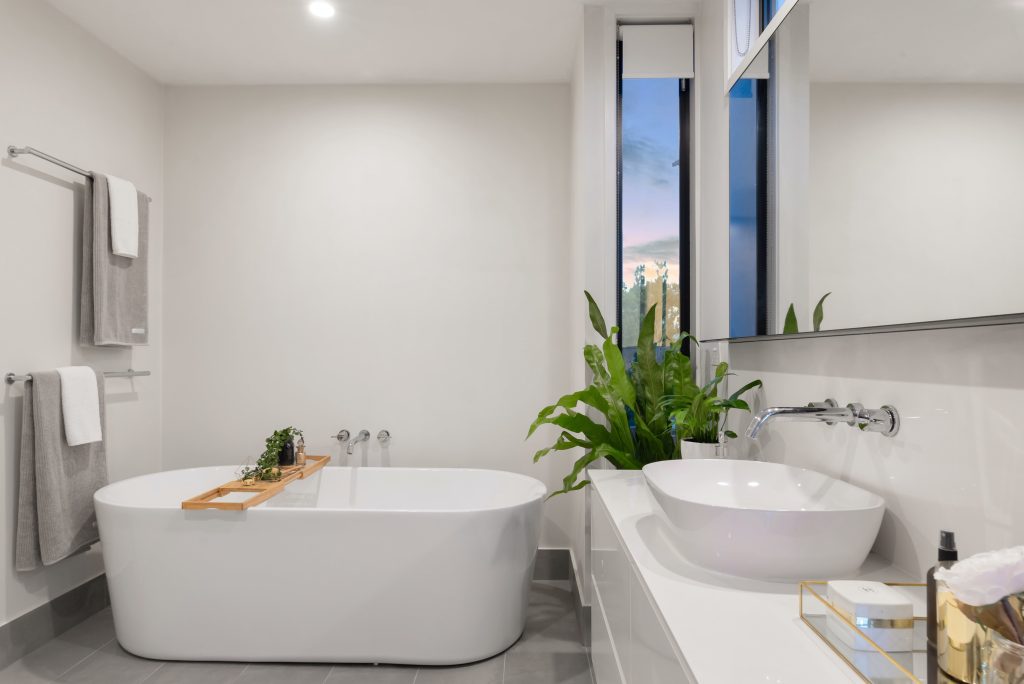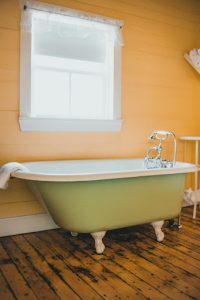
What are Bathtubs Made of? – A List of the 10 Best Bathtub Materials in Australia
Close your eyes and picture this: after a long, tiring day, you find bliss in the soothing warmth of your bathtub. It’s not just a fixture; it’s your personal sanctuary. Of course, it has played a major supporting role in quite a few movies, too. Most famously, Archimedes is rumoured to have had his epiphany about buoyancy in his bathtub, which made him run on the streets, shouting “Eureka, Eureka”!
Whether you prefer a quick shower or a leisurely soak with a drink close at hand, the bathtub is where you can unwind, rest your thoughts, and wash away the stresses of the day. There is something so decadent about soaking in a bathtub, just a sheer sense of comfort while you think about your day or not.
Of course, mundane thoughts about the bathtub material do not really loom large then. But, when you need to decide on the best bathtub for your living space, then questions such as “What material are bathtubs made of?” and “Which makes the best bathtub materials?” become fascinating.
Let’s take a deep soak into the world of bathtubs, explore their history and give you a little more knowledge about the 10 best bathtub materials in Australia.
What Material Are Bathtubs Made Of?
Traditionally, cast iron, copper, tin and even wood, have been the popular bathtub materials. Bathtubs made of Cast iron or richly polished Copper still have their die-hard fans, but they can be difficult to maintain.
Most modern bathtubs are made of materials like thermoformed acrylic, porcelain-enamelled steel, cast iron, or fibreglass-reinforced polyester. Resin and marble are slightly more unconventional choices for bathtub materials.
Like all perfect choices, choosing the ideal bathtub for your bathroom can be a challenging task. With such an abundance of options available, it’s essential to consider factors such as budget, aesthetics, and the appropriate material that suits your needs.
This article explores the best bathtub materials available in Australia, discussing the advantages and disadvantages of each. Let’s start and discover the ideal bathtub material that will suit the décor of your home.
For more informathion: Upgrade Your Home with the Best Bathtubs of 2023 – A Comprehensive Guide
1. Fibreglass Bathtubs
Fibreglass is a composite material composed of fine glass fibres embedded in a polymer resin. It is lightweight, durable, and widely used in various applications, including the construction of affordable and easy-to-install bathtubs.
Fibreglass bathtubs are a popular and affordable option for many homeowners. Made of reinforced plastic, fibreglass bathtubs are lightweight and easy to install. The material is moulded into a bathtub shape and coated with gelcoat resin for added durability.
Pros:
- Affordable: Fibreglass bathtubs are budget-friendly, making them an excellent choice for those on a tight budget.
- Lightweight: The lightweight nature of fibreglass makes it easy to maneuver and install in your bathroom.
- Easy to repair: In the event of any damages, fibreglass bathtubs can be easily repaired or replaced.
Cons:
- Brittle: Fibreglass is prone to cracking and damage, making it less durable compared to other materials.
- Prone to scratches: The finish of fibreglass bathtubs is prone to scratches, requiring careful maintenance.
- Flexibility: Fibreglass bathtubs can flex under pressure, causing them to warp and feel unstable.Buy Bathtubs in Australia
2. Porcelain Bathtubs
Porcelain bathtubs bring a timeless and sophisticated charm to any bathroom, with their construction typically involving cast iron or stamped steel coated in a layer of porcelain enamel.
This enduring method of manufacturing owes its origins to the inventive work of David Buick, a Scottish-born inventor, who, in the 1880s, devised a pioneering process for bonding porcelain enamel to cast iron. The breakthrough was soon embraced by renowned companies like Kohler Company and J. L. Mott Iron Works, initiating the successful marketing of porcelain-enamelled cast-iron bathtubs. Remarkably, this process remains largely unchanged to this day, standing as a testament to its enduring appeal as an ideal bathtub material.
Pros:
- Sheen and lustre: Porcelain bathtubs maintain a beautiful sheen and lustre, adding a touch of elegance to your bathroom.
- Scratch-resistant: The porcelain enamel coating is naturally resistant to scratching.
- Easy to clean: Cleaning a porcelain bathtub is relatively simple, requiring only mild detergent or baking soda with warm water.
Cons:
- Slippery surface: Porcelain bathtubs can be quite slippery, posing a falling hazard.
- Heat retention: Porcelain does not retain heat well, resulting in lower heat retention in your bathwater. You cannot enjoy your bath for too long.
- Vulnerable to chipping: While porcelain is resistant to scratching, it can chip if items are dropped on it.
3. Acrylic Bathtubs
Acrylic bathtubs are popular for many homeowners due to their affordability and versatility. Acrylic is a non-porous material formed by heating and moulding a solid sheet of combined materials such as petrochemicals, stabilizers, resins, fillers, and dyes.
Acrylic bathtubs differ from fibreglass bathtubs primarily in their composition and characteristics. This difference in materials gives acrylic bathtubs a smoother and more luxurious finish, making them easier to clean and more resistant to staining and scratching compared to the textured surface of fibreglass.
Pros:
- Non-porous: Acrylic bathtubs do not absorb water, making them easy to clean and maintain.
- Heat retention: Acrylic retains heat from the water temperature, providing a comfortable bathing experience for you.
- Mildew-resistant: Acrylic repels mildew and stains, ensuring a hygienic bathtub. It is also resistant to most bathroom stains.
Cons:
- Prone to scratching: While not as delicate as fibreglass, acrylic bathtubs can still scratch, requiring careful maintenance.
- Flexibility: Acrylic bathtubs can flex under pressure, making them less stable to stand on.
- Cost: Acrylic bathtubs can be more expensive compared to fibreglass options.
4. Ceramic Bathtubs
Ceramic bathtubs are available in a wide range of size options, shapes, and styles, making them highly customizable to suit your preferences. These bathtubs are constructed by forming numerous ceramic tiles together, which are made of heated clay.
Pros:
- Customizability: Ceramic bathtubs are available in a vast range of size options, shapes, and styles, allowing for customization.
- Lower price range: Ceramic bathtubs can be more cost-effective compared to other materials.
- Durability: Ceramic bathtubs are quite durable and can withstand regular use.
Cons:
- Maintenance required: The grout holding the tiles together requires regular maintenance and replacement.
- Uneven surface: Ceramic bathtubs can feel uneven and bumpy, making them less comfortable for long baths.
5. Stone Resin Bathtubs
Stone resin bathtubs are designed to showcase the natural beauty of stone without the hefty price tag associated with genuine stone materials. They are a blend of crushed stone, typically quartz or granite, and a polymer resin. This combination results in a bathtub that not only exudes durability but also boasts a stunning finish.
Stone resin bathtubs offer matte and glossy options, and custom colours are available. The appeal of these bathtubs lies in their ability to harmoniously blend aesthetics with practicality, making them a popular choice for those seeking a luxurious bathing experience.
Pros:
- Luxurious appearance: Stone resin bathtubs offer a high-end, luxurious aesthetic.
- Durability: Stone resin bathtubs are highly durable and can withstand heavy use.
- Heat retention: Stone resin retains heat well, allowing for a longer and more enjoyable bathing experience.
Cons:
- Cost: Stone resin bathtubs can be more expensive compared to other materials.
- Weight: Stone resin bathtubs can be heavy, requiring proper support and reinforcement.
6. Cast Iron Bathtubs
Cast iron bathtubs are a timeless and sturdy choice for those seeking an elegant, classic look in their bathroom. These bathtubs are made by pouring molten iron into a cast, which is then moulded into the desired shape and coated with a thick enamel layer.
This robust construction not only lends a touch of elegance to your bathroom but also ensures longevity, making cast iron bathtubs a trusted fixture that can withstand the test of time while providing a comfortable and luxurious bathing experience.
Pros:
- Durability: Cast iron bathtubs are extremely durable and long-lasting.
- Variety of styles: Cast iron bathtubs come in a wide range of styles and colours, allowing for customization.
- Heat retention: Cast iron retains heat well, ensuring a warm and relaxing bathing experience.
- Fairly easy to clean: A mix of baking soda and water is usually sufficient to keep your cast iron bathtub sparkling clean. Though, we advise you to keep it dry when not in use.
Cons:
- Weight: Cast iron bathtubs are very heavy and may require additional support during installation.
- Cost: Cast iron bathtubs can be more expensive compared to other materials.
- Installation challenges: Due to their weight, installation can be more challenging and will require professional assistance.Learn more: Relax and Unwind: The Ultimate Guide to the Best Freestanding Bathtubs
7. Copper Bathtubs
Copper bathtubs offer a unique and eye-catching look for your bathroom. Made by hammering multiple sheets of pure copper into a bathtub shape, these bathtubs add a stunning touch of rustic charm and elegance.
Pros:
- Unique aesthetic: Copper bathtubs provide a distinctive and visually appealing look.
- Heat retention: Copper retains heat well, ensuring a warm bathing experience.
- Resistance to mildew: Copper is naturally resistant to mildew and mould.
- Easy maintenance: Copper is quite easy to clean, but may spot if you allow water to dry in the bathtub.
Cons:
- Cost: Copper bathtubs are often more expensive compared to other bathtub materials.
- Weight: Copper bathtubs can be heavy, requiring proper support during installation.
8. Wood Bathtubs
Wood bathtubs are not only a bow to exquisite craftsmanship but also a nod to a rich history dating back to ancient times. Traditionally, wooden bathtubs were widely used in Japan, where they were known as “ofuro.” These elegant tubs served as a vital part of the Japanese bathing ritual, promising relaxation and rejuvenation.
Today, custom-made wood bathtubs can be crafted from various types of wood, such as cedar, teak, or oak, each offering its unique aesthetic and feel. They are found in upscale bathrooms, spa resorts, and high-end luxury homes, adding a touch of natural beauty and warmth to the bathing space. These bathtubs not only provide a stunning visual statement but also create a one-of-a-kind bathing experience that combines modern luxury with the timeless allure of wood.
Pros:
- Natural beauty: Wood bathtubs add a sense of luxury and a unique aesthetic to your bathroom.
- Heat retention: Wood retains heat well, allowing for a warm and cozy bathing experience.
- Long-lasting: With proper maintenance, wood bathtubs can last for a long time.
Cons:
- Cost: Wood bathtubs tend to be more expensive compared to other materials.
- Maintenance: Wood bathtubs require regular maintenance to prevent rotting and maintain their appearance.
9. Stainless Steel Bathtubs
Stainless steel bathtubs are a favourite choice for contemporary homes. They exude modernity and sleekness, fitting seamlessly into modern decor.
Very durable, stainless steel resists corrosion and endures heavy use, ensuring they last a long time. Additionally, they’re easy to maintain and their non-porous surface naturally resists staining. Stainless steel bathtubs offer a combination of durability, aesthetics, and affordability, making them a preferred choice for homeowners looking to elevate their bathroom’s style.
Pros:
- Lightweight: Stainless steel bathtubs are lightweight and easy to install.
- Durability: Stainless steel is highly durable and resistant to scratches.
- Affordability: Stainless steel bathtubs are more budget-friendly compared to other materials.
Cons:
- Heat retention: Stainless steel does not retain heat well, resulting in a quicker loss of warmth once the water has left the bathtub.
- Limited design options: Stainless steel bathtubs may have limited design choices and colour options compared to other materials.Buy Bathtubs in Australia
10. Marble Bathtubs
Cultured marble bathtubs offer a refined and classical look for your bathroom. Since ancient times, marble has been hailed as a beautiful, durable stone perfect for bathing areas. Modern techniques of using silicone as a means of marble maintenance have only increased its lifespan, ensuring your bathroom looks good for decades.
Pros:
- Luxurious Appearance: Marble bathtubs can be sophisticated and stunning focal points in your bathroom adding luxury to the space.
- Durability: Marble is a robust and long-lasting material, and can last for a lifetime.
- Heat Retention: A Marble bathtub has natural heat-retaining properties, and can keep your bathwater warm for a longer period,
Cons:
- Cost: The initial cost of a marble bathtub is significantly higher than other bathtub materials.
- Maintenance: Marble is prone to staining, etching, and damage from acidic or abrasive cleaning products. Also, this bathtub material can be slippery when wet, creating safety concerns.
- Heavy: Marble bathtubs are extremely heavy, and your bathroom floor and subfloor need to be structurally reinforced to support the weight of the tub.
Summary
In conclusion, selecting the right bathtub material is crucial for creating a functional and visually appealing bathroom. Consider your budget, maintenance requirements, and desired aesthetic when making your decision.
Whether you opt for fibreglass, porcelain, acrylic, ceramic, stone resin, cast iron, copper, wood, stainless steel, or cultured marble, each material has its unique advantages and disadvantages. Choose the material that best suits your needs and enjoy a relaxing and rejuvenating bathing experience in your perfect bathtub. Reach out to us at Topware.au to help you choose the best bathtub for your home.




